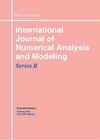A Novel Deep Neural Network Algorithm for the Helmholtz Scattering Problem In the Unbounded Domain
IF 0.7
4区 数学
Q1 MATHEMATICS
International Journal of Numerical Analysis and Modeling
Pub Date : 2023-06-01
DOI:10.4208/ijnam2023-1032
引用次数: 0
Abstract
. In this paper, we develop a novel meshless, ray-based deep neural network algorithm for solving the high-frequency Helmholtz scattering problem in the unbounded domain. While our recent work [44] designed a deep neural network method for solving the Helmholtz equation over (cid:12)nite bounded domains, this paper deals with the more general and di(cid:14)cult case of unbounded regions. By using the perfectly matched layer method, the original mathematical model in the unbounded domain is transformed into a new format of second-order system in a (cid:12)nite bounded domain with simple homogeneous Dirichlet boundary conditions. Compared with the Helmholtz equation in the bounded domain, the new system is equipped with variable coe(cid:14)cients. Then, a deep neural network algorithm is designed for the new system, where the rays in various random directions are used as the basis of the numerical solution. Various numerical examples have been carried out to demonstrate the accuracy and e(cid:14)ciency of the proposed numerical method. The proposed method has the advantage of easy implementation and meshless while maintaining high accuracy. To the best of the author’s knowledge, this is the (cid:12)rst deep neural network method to solve the Helmholtz equation in the unbounded domain.无界域Helmholtz散射问题的一种新的深度神经网络算法
本文章由计算机程序翻译,如有差异,请以英文原文为准。
求助全文
约1分钟内获得全文
求助全文
来源期刊
CiteScore
2.10
自引率
9.10%
发文量
1
审稿时长
6-12 weeks
期刊介绍:
The journal is directed to the broad spectrum of researchers in numerical methods throughout science and engineering, and publishes high quality original papers in all fields of numerical analysis and mathematical modeling including: numerical differential equations, scientific computing, linear algebra, control, optimization, and related areas of engineering and scientific applications. The journal welcomes the contribution of original developments of numerical methods, mathematical analysis leading to better understanding of the existing algorithms, and applications of numerical techniques to real engineering and scientific problems. Rigorous studies of the convergence of algorithms, their accuracy and stability, and their computational complexity are appropriate for this journal. Papers addressing new numerical algorithms and techniques, demonstrating the potential of some novel ideas, describing experiments involving new models and simulations for practical problems are also suitable topics for the journal. The journal welcomes survey articles which summarize state of art knowledge and present open problems of particular numerical techniques and mathematical models.

 求助内容:
求助内容: 应助结果提醒方式:
应助结果提醒方式:


